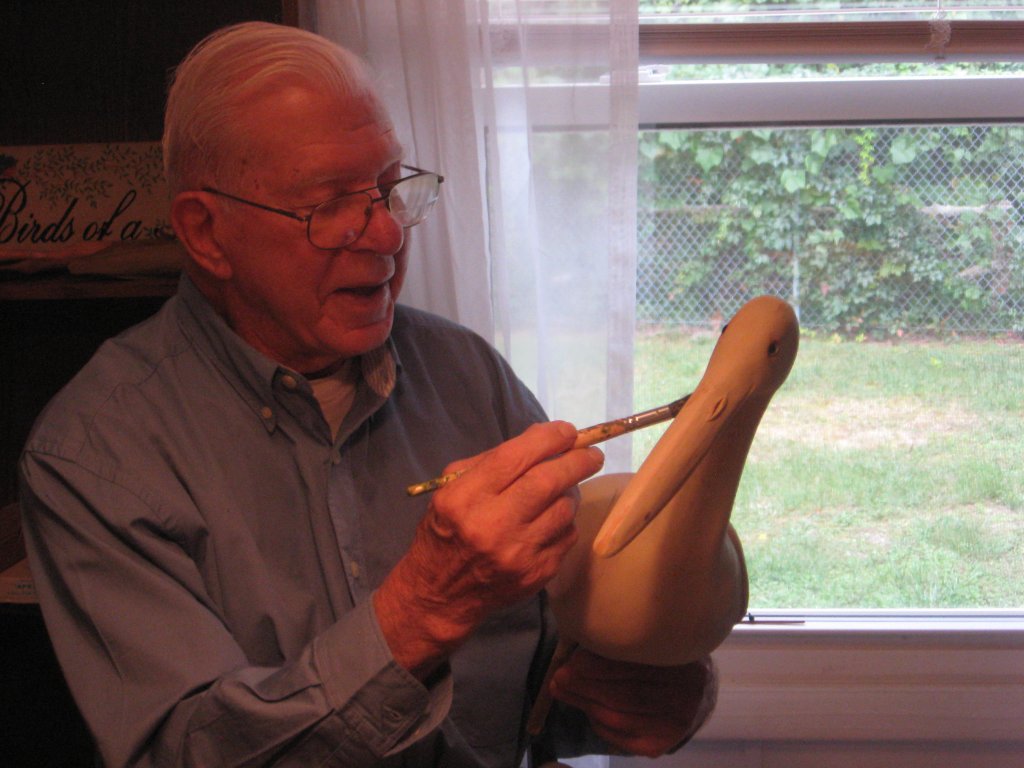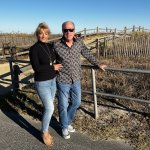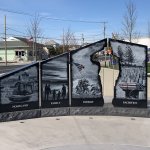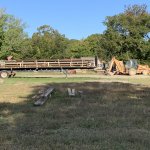SEAVILLE – Harry V. Shourds II has decoy carving in his DNA, though he always aims to put his own mark on his creations. Shourds is the grandson of the influential godfather of American decoy carving Harry Vinuckson Shourds (1861-1920) of Tuckerton, for whom he was named, and father Harry M. Shourds.
The family has deep roots in the area, first going to Cumberland County in the 18th century from Norway and Holland with branches of the family still living in Greenwich.
“Grandfather Harry” was known as the greatest professional decoy maker in New Jersey at a time when Tuckerton was considered the handmade decoy capital of the U.S. His decoys, the vast majority of which are Greater Scaup, Black Ducks, Brant and Canada Geese, can command six-figure prices for prized examples at auction with bidders including Ted Turner and other celebrated collectors.
Shourds carries on the tradition of his grandfather and father by carving in the classic Barnegat Bay style of working decoys with his own distinctive touches which, themselves, carry on the skills and traditions of the local Native Americans, the Algonquin of the Lenni Lenape tribe.
When asked what makes his work so evocative of the birds he’s known first-hand and loved his 84 years, Shourds twinkles his very blue eyes and gives his trademark modest response, “Aw, well, I don’t know.”
Even before the era of Shrouds’ grandfather, the art of making decoys was well established primarily in the U.S. rather than Europe where decoys are not used traditionally in duck hunting, given the more open terrain.
The oldest decoys that have been unearthed archaeologically are estimated to be at least 1,000 years old although duck hunting and carving to support it truly flourished as a sport for the American wealthy in the mid-1800s.
Waterways along the Atlantic Ocean and especially from Tuckerton through Cape May County and on to the Chesapeake Bay developed distinctive styles and crafting processes. Since those early days, decoys have migrated from being used primarily to aid hunting to a new practical use to attract birds for ecological studies and to support efforts to preserved endangered species. Those that are especially well done, both from the past as well as contemporary, are now being collected as contemporary folk art.
Shourds never knew his grandfather but has loads of stories passed down through the family about life in those days. The elder Shourds hunted ducks for market and then Shourds’ grandmother would use the feathers to make pillows and bedding.
“Everything was used from what was hunted at that time,” said Shourds with pride. “My grandparents never sat still and my grandfather in particular was always whittling, even in his spare time and even sitting in the barber’s chair.”
Shourds’ father died when he was just 12, so he is pretty much self-taught as a carver. “It was typical in those days,” Shourds said. “That many carvers were also house painters and used the leftover paint to color the decoys.” Shourds reminisced that his father usually carved in the winter making three or four dozen in the slow season which sold for about $25 per dozen.
How can a decoy aficionado tell it’s a Harry V. Shourds II duck? “Aw, well, I don’t know,” Shourds answered, his blue eyes twinkling again. “I guess there’s something different about my ducks. I hate to copy anyone, even if it’s my grandfather or father, I make my own ducks.”
Shourds uses Jersey white cedar that grows in the ubiquitous swamps of Cape May and Cumberland counties. “White cedar is durable and can be used outside such as for boats and shingles,” explained Harry. “In fact, the roofing of Independence Hall in Philadelphia comes from Jersey cedar from this area.”
Shourds’ decoys are made in two pieces, sliced horizontally and then hollowed out to make them lighter and gives them air space so they won’t crack. Then he puts the pieces together, caulking them just like a boat to prevent them from leaking. The head is attached separately and nailed from the top, just in case it’s broken while in use.
In the bottom, Shourds uses a chisel to make a space to insert about five ounces of lead to provide ballast so that when the decoy is thrown into the water, if it lands upside down it will roll over and sit correctly in the water.
“You want it to ride right in the water so it swims like a duck,” remarked Shourds. Once all construction of the decoy is done, he adds a thin leather piece on the front to tie it to the boat’s anchor rope and then seals and paints the decoy to complete the process.
“While a working decoy must behave like a real duck in the water to play its role in duck hunting, there’s no need to create a duck that totally 100 percent mimics the real one,” Shourds remarked. “Today, carvers are using mounted or frozen ducks and then copy them down to each feather. It makes for something nice to look at but I like to put more of myself into each of my carvings.”
Shourds has been carving full time since 1962 when he decided to devote himself to his art rather than following in his forebears’ footsteps as a house painter. His work has been recognized throughout decades locally, nationally and internationally.
In 1989, Harry received the prestigious National Heritage Fellowship Award from the National Endowment for the Arts in a White House ceremony hosted by President George H.W. Bush. Shortly thereafter, a TV crew from Japan came to film Shourds, honoring him as a highly-respected “cultural treasure” deserving of recognition and efforts to preserve his work as that country does for bonsai, calligraphy and other masters.
Shourds’ decoys, as well as those of his grandfather and father, are showcased objects at the Noyes Museum in Oceanville. Fred Noyes, founder, along with his wife, Ethel, was a collector and supporter of folk art and his original intent in establishing the museum was to showcase it more than fine art as now.
Shourds’ decoys are also on exhibit at the Ward Museum of Wildfowl Art in Salisbury, Md. and the Havre de Grace (Md.) Decoy Museum. He has been featured in Audubon Society Magazine, Birdwatchers Digest and N.J. Outdoors, as well as in the film “In the Barnegat Bay Tradition.”
To contact Camille Sailer, email csailer@cmcherald.com.
Dennis Township – The parents of Dennis Township need to know that their children are not receiving Basic Skills Services. The BSI teacher has been “acting principal” and doing way more admin work than actually…








